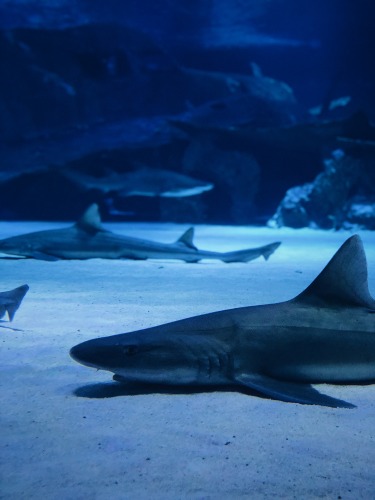Sharks have a significant presence in the nation of Uruguay.
Unfortunately for residents and visitors, multiple shark attacks have taken place there.
The good news is that these shark attacks have not taken place any time recently.
In fact, the most recent reported shark attack that has taken place in Uruguay was in 2004.
To find out more about Uruguay’s shark population, please be sure to check out the following guide.
Contents
So… Are There Sharks in Uruguay?
In a word?
Yes.
The ocean territory in Uruguay is home to a wide range of marine life and sharks are one of the primary species that can be found here.
Sharks are among the most dangerous animals that can be found in this country, but that does not mean that swimmers are constantly under siege.
Since Uruguay borders the Atlantic Ocean to the east, there is no shortage of sharks that can be found here.
The great white shark is the most aggressive species that the country has to offer.
The Atlantic Ocean’s deep waters make for the perfect habitat as well.
That does not mean that you will need to avoid the waters entirely.
It simply means that you will need to take the necessary precautions.
Having the proper level of awareness will save you from any unwanted encounters.
Taking the time to consult with local guides is a must.
They are sure to let visitors know about the waters that need to be avoided.

The shark species list in Uruguay is quite intimidating, as there are a whopping 37 species that can be found in this location.
Let’s take a closer look at the most commonly found species.
Great White Shark
These sharks will always put a significant amount of fear in the hearts of visitors and residents alike because of their inherent danger.
Their aggressiveness makes them one of the most dangerous sharks that the region has to offer.
The depths of the Atlantic Ocean waters that border Uruguay provides the great white with the perfect habitat in which to thrive.
They pose a serious threat to humans if they are approached.
Dusky Shark
The dusky shark can be especially dangerous because of their willingness to subsist on the trash that humans carelessly discard when they are swimming in the waters of Uruguay.
That’s why it is important for visitors to properly dispose of any and all items.
Otherwise, they are attracting the wrong element to their swimming expeditions.
The dusky shark loves to spend time in shallow coastal waters and while they do not have interactions with humans on a regular basis, they should never be approached.
Silky Shark
The silky shark has a unique appearance and can be found all over the region because of its ability to migrate from freshwater to saltwater.
They do not travel as much as other species do, but they have been known to cover large amounts of space within very short periods of time.
The silky shark can be found in oceanic and coastal habitats as well.
Their aggressive nature and size make them a threat to humans that should be avoided at all costs.
Narrow Sawfish
The sawfish is easy enough to spot, thanks to their long and flattened snouts.
These snouts are edged along each side and give way to sizable teeth.
They use their “saws” as a means of stirring their prey up from the bed of the sea.
They have also been known to attack mid-water shoals of fish.
There is no reason for a swimmer to worry, though.
The sawfish is very docile and will only attack a human when they have been captured.
Common Thresher Shark
There are a number of thresher shark species present in Uruguay and the common thresher shark is spotted most consistently.
They are most commonly located in temperate waters but they are not going to pose a threat to humans.
That’s because they are usually found at least 40 to 50 miles offshore, well beyond the swimming distance of any sane human.
They are shy and they do not like being approached, making them harmless to humans.
Mako Shark
The shortfin and longfin mako shark can both be found here.
The longfin has a longer fin (of course), larger eyes, a different body shape and a much darker underside to their snout.
Both species of shark are dangerous to humans, but it bears noting that the shortfin mako is more aggressive.
Mako sharks have not been known for going out of their way to attack humans but that does not stop them from going after various humans, boats, and other vessels.
Is It Safe To Swim In Uruguay?
By and large, the answer to this question is yes, but that does not mean that there are not concerns that need to be addressed.
A visitor cannot simply jump into any body of water in Uruguay and presume that they are 100 percent safe.
For example, many of the best beaches that the country has to offer have lifeguards during the summertime.
Once summertime has passed, these lifeguards are no longer on duty.
Even the most experienced swimmers can struggle with the currents and there is no reason to put your skills to the test.
As for potential shark attacks, these are not concerns that the average swimmer will have to worry about.
Some may see that Uruguay has had four shark attacks over the course of its history and that two have been fatal.
That does not mean that the modern-day visitor is in any real danger.
The last shark attack took place in 2004.
Before that?
A shark attack had not taken place since 1933.
As long as you are consulting with guides and avoiding heavily infested waters, swimming in Uruguay is perfectly safe.
Interesting Shark Facts in Uruguay
Did you know that sharks actually have seven senses?
They share the same five that humans have and their two additional senses are astounding.
They have an electrical sense that allows them to notice electrical currents that are found within the waters they are swimming in.
Their lateral line sense also sets them apart.
This is how they are able to detect their prey and steer clear of potential predators.
Their sense of smell is very important to their survival, as two-thirds of their brainpower is centered on this particular function.
Others may be shocked to learn that some of the largest shark species do not feed on other marine life, instead preferring to munch on plankton.
Sharks are also more diverse from a standpoint than many realize.
While the whale shark can grow to a massive size of at least 12 meters in length, there are other sharks that are much smaller.
For example, the dwarf lanternshark only grows to 17 centimeters.

The vast majority of sharks reside in saltwater, as they require much warmer temperatures in order to survive over the long haul.
There are some species that are able to bounce back and forth between the two but for the most part, “river sharks” are the only ones that are able to reside in freshwater.
A saltwater shark requires temperatures of 75 to 84 degrees Fahrenheit in order to survive.
The river sharks are able to survive in colder waters because their livers are denser and fatter.
The additional oil that they can hold allows them to stay afloat and store more energy.
River sharks are much stockier than saltwater sharks as a result.
Freshwater sharks are also less efficient from a hunting standpoint, so they have to ratchet up their aggression in order to find enough to eat.
Meanwhile, saltwater sharks will typically stick to their known habitats, unless they are forced to migrate or pass through freshwater to get to a different saltwater spot.
3 Safety Tips for Swimming in Shark-Infested Waters
1. Stay Up To Date On Local Trends
You may be an experienced swimmer who has not had any trouble anywhere else, but that does not mean that you are fully up-to-date on Uruguay.
You need to take the time to research local trends so that you are fully aware of what you may or may not be getting yourself into.
Some bodies of water may have more shark sightings closer to the shore during different times of the year.
Patterns vary by species and place, so be sure to educate yourself.
2. Wear Darker Colors
“Sharks have a monochromatic vision, so it would be smart to avoid colors like white, yellow, and/or neon when swimming or diving because those may stand out more brightly in a blue ocean.
Sticking to darker colors, like black and blue, can minimize unwanted attention from sharks,” says Taylor Cunningham, a shark safety diver who also works as a marine biologist and shark conservationist.
While the color of your swimming gear and your clothing may not matter to you, it matters greatly to a shark that is in search of prey.
3. Make Eye Contact If Necessary
If you happen to come across a shark, your first instinct will be to backpedal and swim away as quickly as possible.
This is the wrong move.
You will want to make eye contact, to convey that you are a predator and not prey.
Backpedaling and taking off convinces the shark that you are someone who should be chased immediately.
Don’t make lots of noise, splash or cause any sort of scene.
The shark will believe that you are going to be on their menu.
Summary
The presence of sharks in Uruguay should not keep you from swimming there for any reason.
As long as you are taking the necessary precautions and avoiding dangerous beaches without lifeguards, there is no reason to panic.
Shark attacks are increasingly infrequent in Uruguay and there is nothing for a visitor or resident to worry about in this regard as long as they are not being overly reckless.
Uruguay Safety Overview
READ THE FULL REPORT: Uruguay Safety Review
Safety Index:
- OVERALL RISK: LOW
- TRANSPORT & TAXIS RISK: LOW
- PICKPOCKETS RISK: LOW
- NATURAL DISASTERS RISK: MEDIUM
- MUGGING RISK: LOW
- TERRORISM RISK: LOW
- SCAMS RISK: LOW
- WOMEN TRAVELERS RISK: LOW
Frequently Asked Questions
Are Uruguay Shark Attacks Frequent?
Absolutely not.
In fact, it has been 18 years since the last shark attack took place and it was not fatal.
Before 2004, the most recent shark attack had taken place in 1933.
Neither of these attacks was fatal.
How Do I Avoid Shark-Infested Waters?
Uruguay has a number of guides who are heavily invested in making sure that visitors and residents do not accidentally make their way into shark-infested waters.
Be sure to consult with them as needed.
Are Uruguay Beaches Tropical?
No.
The beaches that you are going to find in this country are Atlantic and they are all located entirely below the tropical line.











